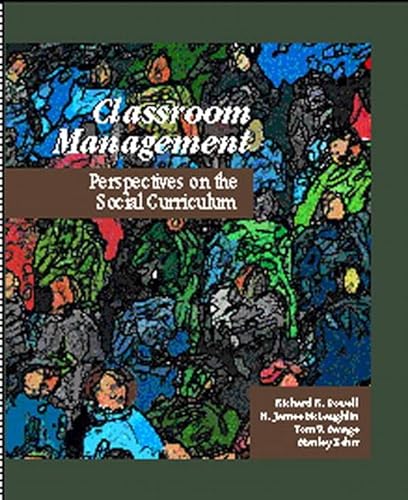Items related to Classroom Management: Perspectives on the Social Curriculum

Synopsis
This book provides ongoing activities to equip teachers with the ability to construct and refine their existing personal theories, philosophies, and metaphors for managing culturally diverse classrooms. The authors' unique approach of combining diversity issues with management issues challenges readers to conduct action research on a topic that brings the two themes together. Specific coverage of very practical aspects of classroom management includes developing routines, promoting responsibility, and responding to problems. This content helps teachers come to terms with the day-to-day reality of working on management with parameters of diversity. For teachers of all grade levels.
"synopsis" may belong to another edition of this title.
From the Back Cover
This book provides ongoing activities to equip teachers with the ability to construct and refine their existing personal theories, philosophies, and metaphors for managing culturally diverse classrooms. The authors' unique approach of combining diversity issues with management issues challenges readers to conduct action research on a topic that brings the two themes together. Specific coverage of very practical aspects of classroom management includes developing routines, promoting responsibility, and responding to problems. This content helps teachers come to terms with the day-to-day reality of working on management with parameters of diversity. For teachers of all grade levels.
"About this title" may belong to another edition of this title.
FREE shipping within U.S.A.
Destination, rates & speedsSearch results for Classroom Management: Perspectives on the Social Curriculum
Classroom Management: Perspectives on the Social Curriculum
Seller: World of Books (was SecondSale), Montgomery, IL, U.S.A.
Condition: Good. Item in good condition. Textbooks may not include supplemental items i.e. CDs, access codes etc. Seller Inventory # 00069130310
Quantity: 1 available
Classroom Management: Perspectives on the Social Curriculum
Seller: ThriftBooks-Dallas, Dallas, TX, U.S.A.
Paperback. Condition: Very Good. No Jacket. May have limited writing in cover pages. Pages are unmarked. ~ ThriftBooks: Read More, Spend Less 1.2. Seller Inventory # G0134609085I4N00
Quantity: 1 available
Classroom Management: Perspectives on the Social Curriculum
Seller: Goodwill of Silicon Valley, SAN JOSE, CA, U.S.A.
Condition: very_good. Supports Goodwill of Silicon Valley job training programs. The cover and pages are in very good condition! The cover and any other included accessories are also in very good condition showing some minor use. The spine is straight, there are no rips tears or creases on the cover or the pages. Seller Inventory # GWSVV.0134609085.VG
Quantity: 1 available
